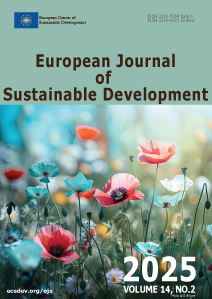Electric Vehicle Charging Station Utilizing Highly Concentrated Photovoltaic System Combined with Lithium-Ion Batteries
DOI:
https://doi.org/10.14207/ejsd.2025.v14n2p266Keywords:
High concentrated PV, multi-junction solar cells, lithium-ion battery, electric vehicle, weather conditionsAbstract
Combining highly concentrated photovoltaic (HCPV) modules and battery storage systems attain high power- density than other ones using separate elements. This work aims to examine the performance of electric vehicle (EV) charging station utilizing an HCPV system integrated with lithium-ion batteries in Kuwait. HCPV system is integrated with EV, battery storge system, and AC grid as a four-component system for EV charging station at an educational building located in Kuwait. A theoretical technique is developed to calculate the proposed system efficiency. A simple algorithm is utilized to calculate the reduction of greenhouse emissions due to the use of HCPV-EV. Energy produced from HCPV modules is used to charge four EVs, battery system, supplying energy to building electrical appliances and feeding remaining energy to the grid. Present results reveal that HCPV energy utilized for EV charging represents 81% of the total load needed to charge EVs and about 90% of the energy required for EV charging through the utilization of HCPV modules and battery system which can potentially reduce operating costs of charging EVs. Only about 10% (1218 kWh) is required to be exported from the grid to fully charge EVs. Also, an integrated HCPV system and battery can provide 93% of the total load required resulting in a big saving in electricity bill. Also, the HCPV system can feed the utility by 11458 kWh, resulting in an additional decrease in building consumption costs. In all months, the performance ratio (PR) of the proposed integrated system is higher than 80%, indicating the reliability of the proposed HCPV integrated system. Battery state of charge (SOC) exceeds 70% through most year months indicating the reliability and durability of lithium-ion storage batteries. Finally, predicted CO2 emissions avoided because of utilizing an integrated HCPV system at an optimum tilt angle is 12410 kg/year resulting in significant environmental enhancement.
Keywords: High concentrated PV; multi-junction solar cells; lithium-ion battery; electric vehicle; weather conditions.
Downloads
Published
How to Cite
Issue
Section
License

This work is licensed under a Creative Commons Attribution-NonCommercial 4.0 International License.





